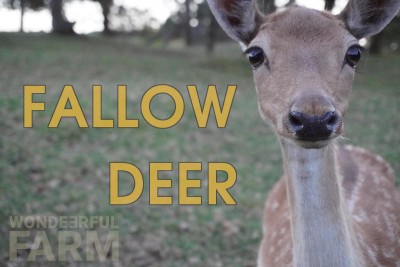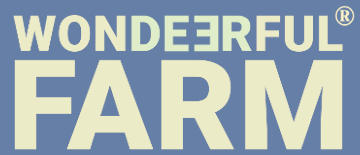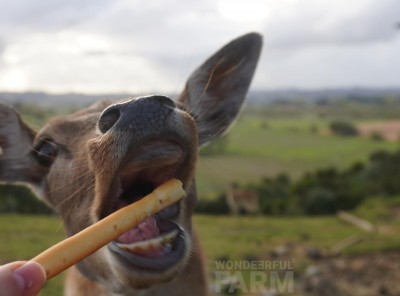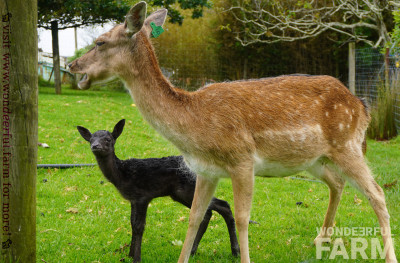Fallow Deer (Dama Dama)
» Deer stories » Deer facts » Fallow Deer (Dama Dama)Want to know more about European fallow deer? Good news: this website is about them primarily. This is the kind of deer we have on our farm.
Fallow deer, or European fallow deer (Dama dama) is a medium-sized deer. The characteristic feature of the European fallow deer is its wide antlers, plus, they are one of the few species of deer that don’t lose their spots a few months after birth.

on the photo: a yearling - 1 year old deer (doe, fallow)
Fallow Deer Distribution
European fallow deer are indigenous to the Mediterranean area, and Presumably, the original area was limited only to Asia, but they have since been introduced to 38 countries spanning all continents, making them one of the most widespread ungulates in the world.
In New Zealand, they are found in most regions in both the North and South Island but their distribution is rather patchy.
Fallow Deer Appearance
So what's fallow deer size and how do they look? Fallow deer are much larger than roe deer, but smaller and noticeably lighter than red deer. The main feature of the European subspecies is the length of the animal within 1.30-1.75 meters, as well as the presence of a tail no more than 18-20 cm long.
The height at the withers of an average mature animal does not exceed 80-105 cm.
The average weight of an adult male is 65-110 kg, and female - no more than 45-70 kg.
European fallow deer are somewhat smaller than Iranian or Persian fallow deer (Dama Mesopotamica), and their body reaches a length of 2.0 m or even more. A fallow deer of this genus is distinguished by a more muscular body, as well as rather short necks and limbs, in comparison with a red deer. The antlers of the European fallow deer, in contrast to the Mesopotamian type, can have a spade-like shape. Persian deer has traditionally been considered to be a subspecies of the fallow (as Dama Dama Mesopotamica), but today it is also treated as a distinct species (Dama Mesopotamica) by some authors, so it's status is disputed. What is beyond dispute is that the two kinds look almost exactly the same, if you ignore the difference in size.

Persian Fallow Deer, © depositphotos
In April, all old males of the European fallow deer shed their antlers, and newly formed ones appear in animals only at the end of summer, around August.
In the first two years of fallow buck's life, the antler is a single unbranched spike. In fact, that's why we call them 'spikers'.
The color of the fallow deer changes with the seasons. In summer, the coloring of the animal on the upper part and at the tip of the tail has a reddish-brown tint with white, rather bright spots. There are lighter colors on the underside and on the legs.
Recently, white and black colorations have become quite common due to their attractive appearance.

on the photo: white fallow deer (buck and doe)
With the onset of winter, the head of the animal, the neck area and ears of the European deer acquire a dark brown coloration, and the spots all over the body fade away.
Fallow Deer Lifestyle
In their way of life, the European fallow deer are similar to red deer, but less picky, therefore they prefer mainly spacious pine groves and safe park landscapes.
In the same time, fallow deer are less fearful and cautious, and are not inferior to red deer in movement speed and agility.
On summer days, European fallow deer prefer to stay apart, or in small groups. Except for this year's fawns, who stick with their mothers.
The period of main activity falls on cool morning and evening hours, when animals graze or come to watering places.
In the hot daytime hours, the fallow deer settle down to rest in the shade of a bush or directly near various bodies of water, where there is no annoying gnats.
Animals living in park zones quite easily become practically tame, being able to take food from a person's hands.
Fallow Deer Mating
In late autumn, these animals gather in rather large herds of females and males.

fallow buck with antlers
At the same time, buck contests take place.
Battles for the female during buck fights are so fierce that the males often break each other's necks and even their own, so both rivals may well die.
No bucks were injured during this fight:
Full video of this incident is here.
The winning bucks will have a chance to mate with several does.
Fallow bucks, despite their small size, differ from red deer in greater aggressiveness and assertiveness.
During the rut and the mating period, the red buck follows his females and protects them from other males, announcing his rights to rivals with roaring.
Fallow buck, having won their chosen ones from rivals, dig small holes in the meadow for sitting (called rutting pits). Of the many pits, females choose those located closer to the middle of the meadow, because the strongest males who have proven their advantage in a fight settle in them.
The buck will often pick a doe from the herd and pursue her until she mates with him. Chasing can last for up to two days. Should the doe lie down to rest the buck will force her to stand up her with blows of hooves and horns. If the male himself is exhausted, then he lies at a short distance from the female and rests for two to three hours. But as soon as the doe gets up and makes attempts to rejoin the herd, he instantly blocks her path and drives her in the opposite direction. After mating, the males do not disturb the females and they can safely graze and rest with the herd.
During the mating period, male fallow deer make special roaring sounds. Since many animals can live in one territory at the same time, this incomparable, guttural, rolling sound fills the entire forest.
And in order to call the opponent to fight, fallow bucks make other, rumbling noises.
Please read and watch (!) more on deer mating season (rut).
Fallow Deer Lifespan
Curious fact: Dama Dama lived on Earth back in the times of the Ice Ages, together with now extinct giant deer (Megaloceros).
As observations show, the average life span of the European fallow deer in natural conditions is: for males - about 10 years, and for a female - no more than 15 years. In captivity, an animal can live for about a quarter of a century.
Fallow Deer Habitat
The natural range of fallow deer covers almost all European countries that adjoin the Mediterranean Sea, as well as northwest Africa and Egypt, Asia Minor, Lebanon and Syria, and Iraq. These species prefer to live in forested areas with numerous lawns and open areas. But they are able to adapt very well to various spheres of habitation, therefore they are found even on the island territory in the North Sea. The number of fallow deer varies depending on the terrain in the regions, but in some cases reaches about eight dozen individuals.
The habitat of the fallow deer is extensive and these animals can be found in many parts of the world.

fallow doe and leaping fawn
Fallow Deer Diet
What do fallow deer eat? The diet of these ungulates is very diverse.
In summer, they eat sedges, various umbrella plants, cereals and legumes. In early spring, they eat anemone, corydalis, snowdrops.
The spring diet is supplemented with shoots of maple, oak, mountain ash and pine, young shoots of shrubs. In winter, the basis of food for deer, in the absence of feeding, is twigs.
Lacking mineral salts, fallow deer, like other species of deer, visit salt licks (mineral licks), both natural and artificial that were specially arranged for them. Animals can be observed licking, and sometimes gnawing on the soil that contains an increased amount of salts. They begin to visit salt licks especially regularly in spring, early summer (from March to June) and in autumn (in August - September).
On hot and dry days, fallow deer visit salt licks reluctantly and come to them, as a rule, after the rain.
Now when it comes to farm and zoo animals, those living close to humans, they can eat all sorts of human food. For example, deer happily chomp down on carrots, pumpkin, cucumbers, watermelon, bananas, bread and even spaghetti. But be warned - deer can get in trouble or even die from ingesting wrong food or wrong amount of it. For more information, please see our post on feeding deer.
Fallow vs Red Deer
| Fallow vs Red Deer Comparison | ||
|---|---|---|
| Fallow Deer | Red Deer | |
| Scientific Name | Dama dama | Cervus elaphus |
| Adult Weight | 35-200 kg | 90-300 kg |
| Body Length | 130-190 cm | 160-250 cm |
| Shoulder Height | 85-110 cm | 100-150 cm |
| Antler Shape | Palmate with numerous points | Branched with typically 5 or more points |
| Antler Size | Smaller | Larger |
| Coat Color | Variety of colors, including white, black, and brown with spots | Dark reddish-brown, grayish-brown, or dark brown with no spots |
| Coat Texture | Soft and woolly in winter, short and sleek in summer | Short and sleek |
| Habitat | Woodlands, grasslands, and farmland | Woodlands, grasslands, and mountainous regions |
| Diet | Grazes on grasses, herbs, and shrubs | Grazes on grasses, herbs, and shrubs, and browses on leaves and shoots |
| Lifespan | Up to 16 years in the wild | Up to 25 years in the wild |
| Predators | Wolves, bears, and humans | Wolves, bears, and humans |
| Behavior | Social and gregarious, form herds | Generally solitary or in small groups |
| Rutting Season | October to November | September to November |
| Gestation Period | 7 months | 8 months |
| Offspring | Usually one fawn, twins are rare | Usually one calf, twins are common |
Last modified 2023-02-22 at 13:29
Published 10 March 2021
Add your comment
More «Deer facts» stories
Inside A Deer's Mouth. Deer Teeth.
Do deer have upper teeth? How does deer mouth look on the inside? Deer have baby teeth, just like people do...
read more...
Are Deer Omnivores, Carnivores or Herbivores?
Deer farmers about deer diet. Do deer eat meat, are deer omnivores, are deer carnivores or are they true herbivores? Can deer eat animal protein, meat? Can deer eat animal protein, meat?
read more...
All About Baby Deer (Fawns)
In this post, we'll answer some common questions about baby deer and share a few photos and video of Charcoal the newborn fawn. When baby deer are born, can fawns survive without a mother, can baby deer walk right away?
read more...
 '
'


